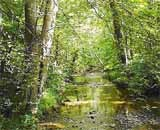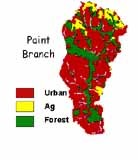Restoration Success
Maryland success combines restoration with watershed management
Case study courtesy of Dr. Margaret Palmer, National River Restoration Science Synthesis
What does one county in Maryland have in an urban area that many other counties envy? Trout! Not stocked trout, but naturally reproducing trout!
The Upper Paint Branch Watershed has water that is clean and cool enough for juvenile and adult trout to thrive, with streambeds healthy enough for spawning, and habitat rich enough to support abundant prey for young-of-the-year fish.
 The Paint Branch Watershed lies just north of Washington, D.C. Its small streams are tributaries to the Potomac River, which eventually flows to the cherished Chesapeake Bay. The watershed has a large amount of impervious (paved) surface and has many popular suburbs for commuters working in or near the nation's capital.
The Paint Branch Watershed lies just north of Washington, D.C. Its small streams are tributaries to the Potomac River, which eventually flows to the cherished Chesapeake Bay. The watershed has a large amount of impervious (paved) surface and has many popular suburbs for commuters working in or near the nation's capital.
It is very densely populated as indicated below by the urban development shown in red. Nevertheless, the upper portions of the watershed have thriving trout.
 What is responsible for this success story?
What is responsible for this success story?
Starting in the early 1990's, Maryland National Parks and Planning Commission (MNPPC) purchased much of the undeveloped land along the critical spawning/nursery tributaries, which provided shaded habitat and abundant inputs of riparian leaf litter (fueling the stream's food web) for much of the stream's length.
In 1995, the Montgomery County Council designated the upper Paint Branch watershed as a Special Protected Area, under a county law that provides additional protections to designated sensitive areas.
MNPPC developed protection plans, including an Environmental Overlay Zone, in which impervious area is limited to 10% on all new development in the SPA portion of the watershed.
Environmental planners in the MNPPC and in the Montgomery County Department of Environmental Protection also design and carry out projects to restore major tributaries and sections of the mainstem through stormwater management activities and channel restoration.
The extensive parkland acquisition and comprehensive SPA requirements coupled with the 10% imperviousness cap (on new development) were essential steps to protect the resource. Watershed restoration efforts have continued to improve watershed conditions.
Key restoration projects include efforts to deal with the runoff from previously developed areas and mitigate habitat damage that had occurred before the SPA program was established.
The Montgomery County Department of Environmental Protection worked with the park system and other state agencies to inventory some 75 potential stream habitat restorations, wetlands creation, and stormwater retrofit opportunities. As of June 2002, seven of these projects had been completed in portions of the upper Paint Branch watershed and the program continues today.
Extensive biological and habitat monitoring before and after restoration have been instrumental in ensuring that the restoration projects are guided by sound scientific principles.
Restoration + Ecological Monitoring + Watershed Planning = Success!
One important restoration project involved placing a by-pass pipe to redirect stormwater from a subdivision surrounding a Paint Branch tributary to the mainstem.
The pipe eliminated a thermal barrier to trout entering the tributary by keeping water cool and by reducing peak flows during storms. Prior to the restoration effort, warm water discharge (runoff from roads and a storm water management pond) entered the stream.
Temperature sampling stations in the tributary in place prior to and following the effort showed that the by-pass pipe resulted in water temperatures 2.6 - 4.2 degrees (F) lower than before it was installed.
Because the pipe was buried underground where soil temperatures are always much lower than aboveground, the water in the pipe cooled as it flowed through the pipe.
Indeed, by the time the water reached the mainstem, it was cool enough that temperatures below the outfall in the mainstem decreased by an average of 0.6 degrees.
Young-of-the-year trout were found in Gum Springs by the summer of 2001. In the prior four years, at most only one or two fish were found during annual surveys; during the 2001 sampling, however, 21 young-of-the-year were found at one site alone.
Other restoration projects have improved habitat, minimized bank erosion, decreased siltation, and made the watershed more aesthetically appealing to the surrounding community. Click here to learn more (PDF).
Below are photos of one of the most recent restoration projects:


Prior to restoration -- the channel was heavily incised and downstream there was evidence of failed attempts to prevent channel movement using concrete.

Following restoration, channels were regraded, habitat diversity was enhanced and efforts to minimize siltation of the channels were apparent.

